McLaren 720S: First Drive
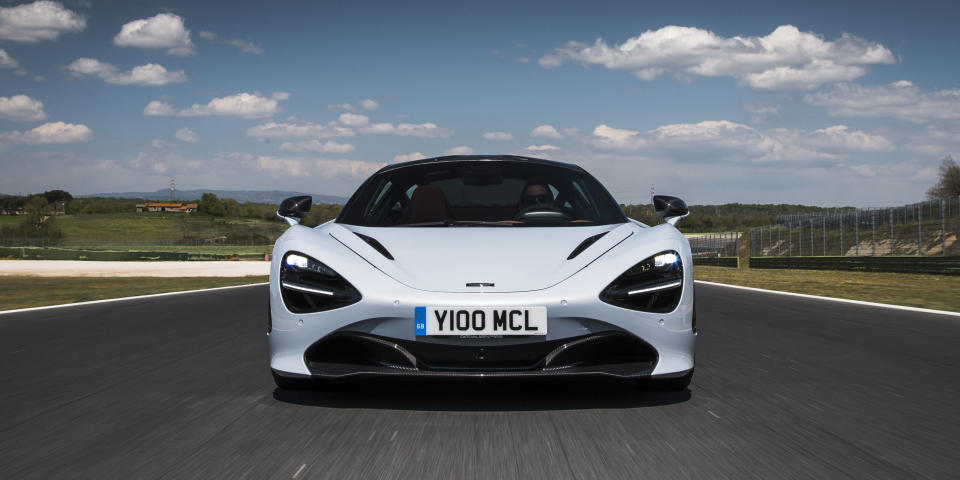
"They got hit over the head. We all know it, that the car didn't demonstrate enough energy, creative energy – passion, you could call it. It never looked wrong, it just looked ho-hum. It's like an athlete with an incredible figure wearing a sack."
That's what McLaren Automotive's Design Director Frank Stephenson had to say about the company's original supercar, the MP4-12C, a car that had its design finalized before he even started.
In approaching its comeback supercar with a race team's focus, McLaren made a crucial miscalculation. The 12C lacked the one thing that you can't put a number on: wow factor. And that was something the Band-Aid 650S rebranding could never fully fix. The 720S doesn't have that problem. Not close. This car is all wow.
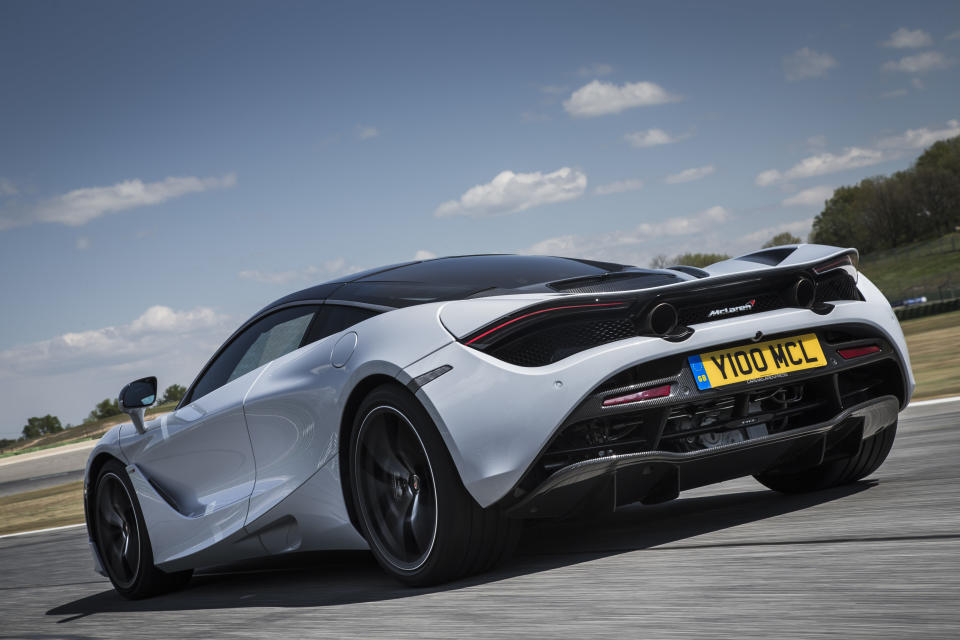
The 720S is as polarizing as the 12C was bland, as innovative as its ancestor was predictable. Take the eye-socket headlamps, which cleverly, but controversially, take a tip from the tuner world, turning the headlamp hole into air intakes, and use slim LED lamps bridging the chasm for illumination. You might not like the way they look, but you'll admire them a whole lot more once you appreciate the science behind the styling.
Same with the rear quarter panels. The gaping air intakes convention says all mid-engined cars need between the rear wheel and the door are gone. They're hidden behind a fake door skin, the McLaren 570S's door 'tendon' bar taken to the next level.
If the visual effect is striking from the outside, revealing the long wheelbase in all its glory, like a drag motorcycle with its extended swing arm, it's no less jarring from beneath the bubble canopy. From the driver's seat I can see the division between the inner and outer body panels as I power down the start finish straight at Rome's Vallelunga race circuit. I've driven here a couple of times before, most recently in an Audi RS3, and before that for the launch of the original Lamborghini Aventador. So, basically never in anything that actually wanted to turn. Consider that remedied.
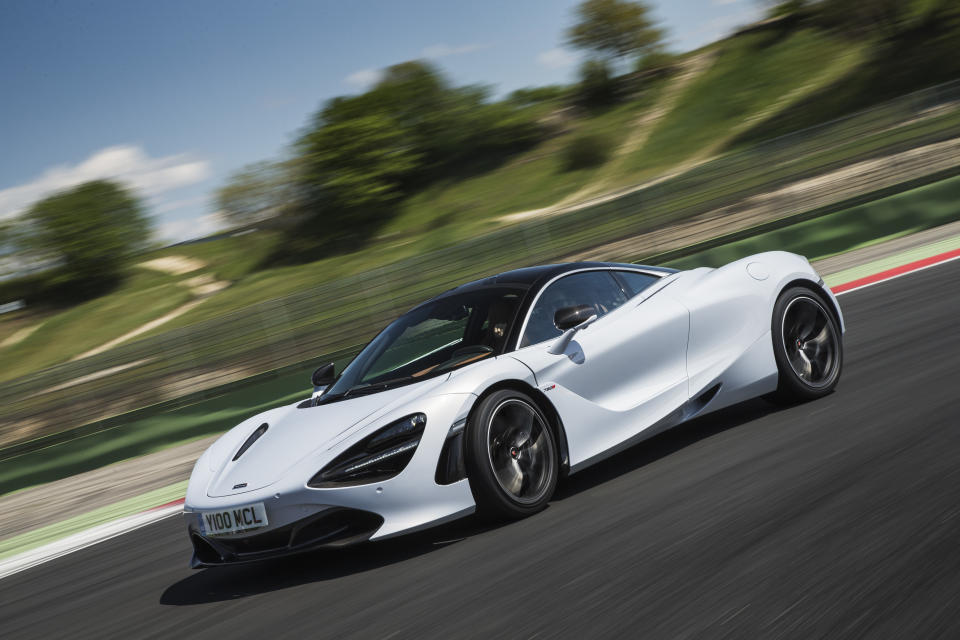
The 720S loves to turn. The steering is weightier this time because of geometry changes that increase the castor, but that only adds confidence as you nudge the wheel away from center, feeling the tires filtering the vital messages back to your hands.
And that's real feel, not the virtual panacea we so often get fobbed off with these days. McLaren tried electric-assist steering racks during development but couldn't get any to deliver the feel they wanted. The 720 keeps its hydraulic steering. It's not your turn yet, electric-assist.
Who'd have believed, even 15 years ago, that a supercar this powerful could be so forgiving? Driving the 720 hard feels entirely natural from the first corner as you push to the front tire's limits, feel the wheel lighten as you brush the brakes, then ease back on the gas to gently load up the rear tires. The balance is delicious, the way you can tease it by massaging the gas pedal, absolutely intuitive. It has that purity in its agility that you only get from being ruthless about mass.
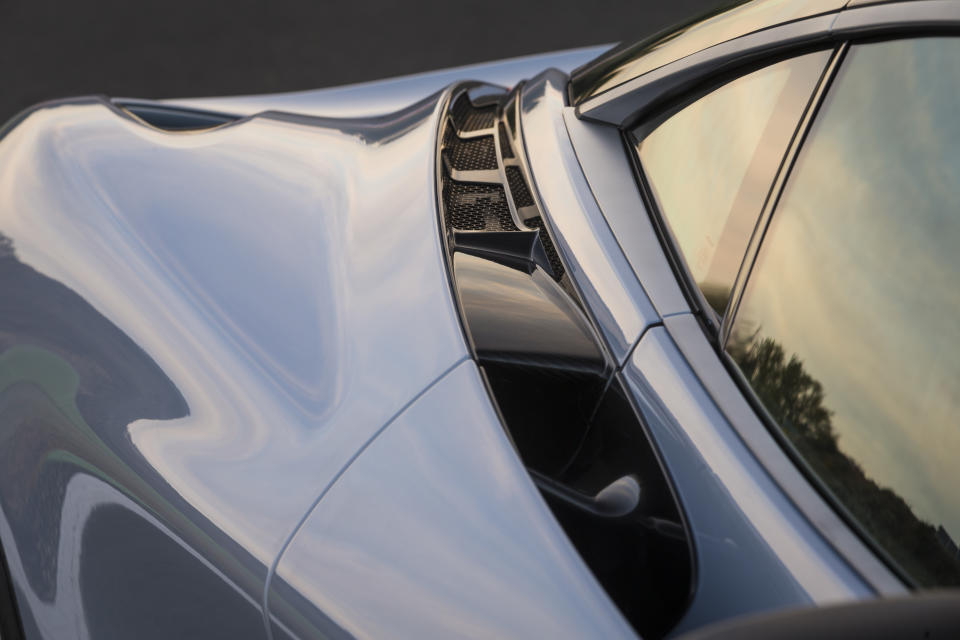
Only a few weeks before this I drove the Bugatti Chiron, a car whose acceleration is so freakish it feels like it could sieve your internal organs through the pores of the skin on your back. A car that wants to convince you that trick's enough to forgive a gargantuan curb weight. Driving the 720S reminds you that it's never forgivable to let a sports car knock on the door of 4500lb, no matter how much performance it offers in payback.
The 720S weighs 3128lb full of fuel and a driver, and no doubt could have come in even lighter if McLaren had used the conventional sway bars it gave the 570S rather than the hydraulic roll control system the more senior cars get. But then it wouldn't be able to react to the dip at turn one, or the banking at turn two, nearly as quickly. McLaren calls this Proactive Chassis Control II. The hardware is essentially the same, but 12 extra sensors allow it to anticipate, rather then simply respond to situations.
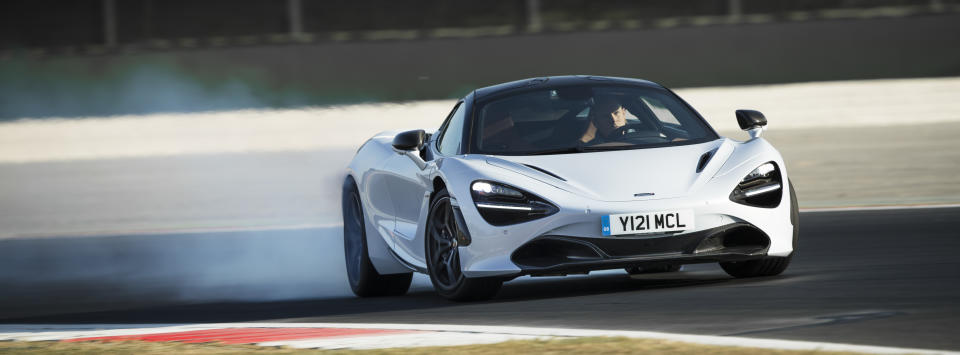
PCCII might not sound sexy but owners will get more benefit from that than the new 'Drift Control' function, an ESP-based stability system that lets you tailor the amount of slide by sliding a finger left or right across a graphic on the nav screen. Not since the Mustang II King Cobra's graphics package has performance been so oversold: this is more 'slight oversteer' than 'drift' and we'd need more time to be sure about its consistency, though the idea of helping novice drivers approach the 720S huge limits in safety is sound.
Gadget fans will also appreciate the telemetry option that shows sector and lap times for the circuit, plus a trace that rises and falls to show braking and acceleration. Later, in the pits, I compare mine with chief test driver Chris Goodwin's: his looking like a graph of gas prices through the 1970s, mine like toilet paper sales over the same period.
But caught up in the moment, in the act of actually driving, you feel every bit as heroic as Goodwin. Taking the jink right after the pits with your foot buried deep into the carpet, pulling the car left again then standing on the middle pedal with all your might, marveling at stability the 650S never had, and catching a glimpse in the rear view mirror of the now-full-width rear deck spoiler hurling itself into the slipstream in airbrake mode: hot lapping the 720S an absolute scream. The only thing it can't do is scream back.
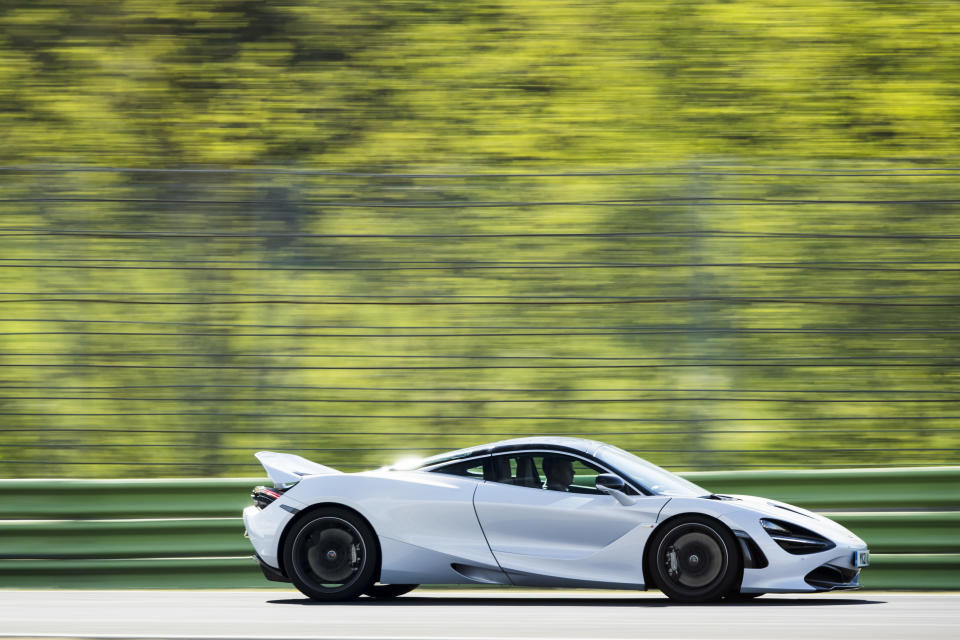
Behind your head, buried so low in the aluminum rear subframe that there's sadly nothing to see whatsoever, is an evolution of the engine that has underpinned every modern McLaren from the entry-level 540C to the halo-model P1 in some form or another.
A longer stroke takes it from 3.8-liters to 4.0. Power is up from the 641hp of the 650S to 710hp, or 720PS. Even the P1 only made 727hp before you factor in its hybrid add-on, and that car cost four times as much. This is proper next-level performance, taking the ordinary mid-range supercar to hypercar levels of go.
On paper, it's a monster, dispatching 62mph in 2.8sec and 124mph (200kmh) in 7.8sec. A Ferrari 488 GTB needs 3.0 and 8.3sec respectively. On pavement, it's no less impressive, spinning to 8000rpm, and feeling noticeably less laggy in this incarnation thanks to some new low-inertia twin-scroll turbos.
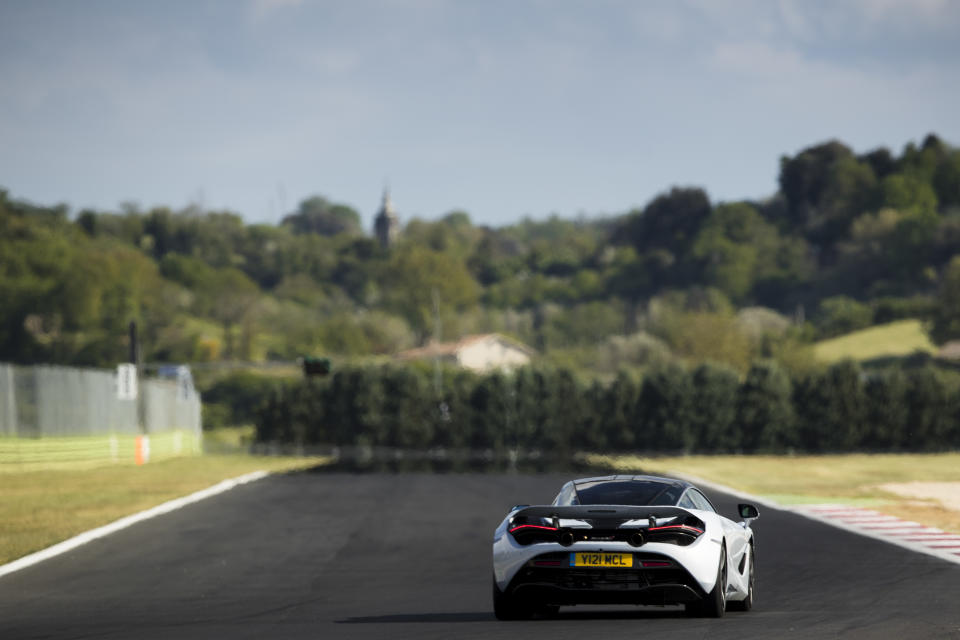
With the stock exhaust, you'd never know it. There's no flamboyant fanfare when you push the start button. Push the gas pedal and there are no sonic fireworks. If you want crazy noise, opt for the sport exhaust, which McLaren says is 30 percent louder and has a feature called 'loud start.' While the lack of sound from the regular exhaust might no impress everyone who gets in the car for 10 minutes, it's likely to win you over long term.
The 720S asks an existential question of the supercar: aren't these cars actually bought solely to administer shots of adrenaline in 10-minute long doses?
It certainly seems McLaren believes otherwise, like it wants you to think hard before walking past this and taking the Range Rover, or the E63, even if you are just commuting to work. The carbon chassis, which, along with the dihedral doors is unique in this sector, is now a 'monocage' including an integrated central roof bar, rather than a simple tub.
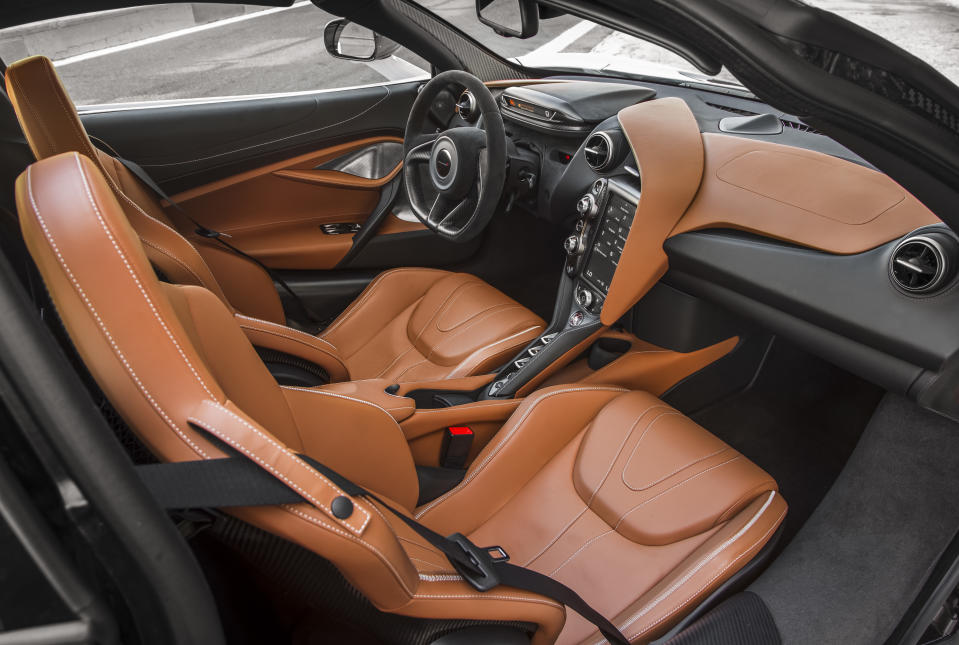
More than the extra stiffness this provides, what you notice is the way it's allowed McLaren's engineers to cut the rocker panel deep towards the floor at the base of the A-pillar. Instead of falling butt-first into the seat like you've tripped backwards down a well, you can actually climb aboard with some dignity. And now that the doors require 155mm less space to swing open, you can actually get out of the thing in a tight parking garage space too.
That's the surprise about the 720S: it looks like a nightmare to live with but is anything but. The visibility is excellent, both forward, past the A-pillars with their exposed carbon weave, a nice show-off touch–and more surprisingly, at the back.
Less so if you make use of the huge cargo area under the rear part of the canopy. McLaren dropped the engine's induction plenums by 4.7in, creating a new 7.4cu ft luggage space behind the rear seats that would be even more useful if the glass above it was hinged like it is in the 570GT. Factor in the generous 5.3cu ft space in the nose that swallowed two rolling bags full of camera gear on our way to the airport and you're looking at a supercar that thinks it's a GT.
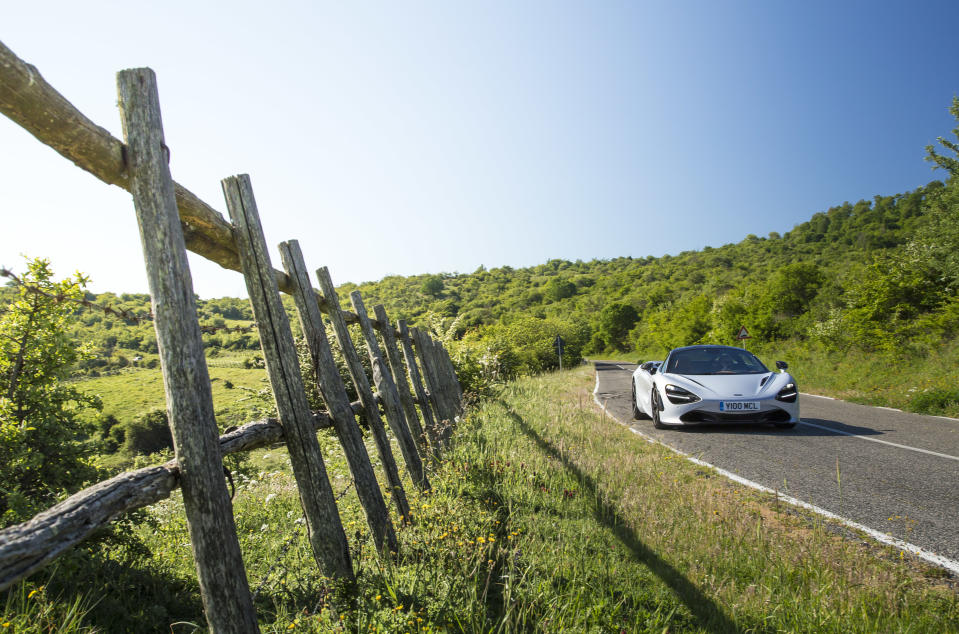
And rides like one. Italy's roads are as rough as Germany's are smooth. The pavement is frequently broken and uneven and strewn with irritating little Fiats that we swat away with a squirt of right foot. The McLaren doesn't care. No, it's not an S-Class, but for a supercar like this, the McLaren is exceptionally comfortable.
As with other McLarens you still have to press the Active button on the dash before you can mess with the twin toggle switches governing the chassis and drivetrain setup. The difference this time is the car defaults to the medium 'Sport' setting in each. Switch to 'Track' and as well as the changes to roll stiffness and throttle mapping, the instrument binnacle swivels downwards to reveal a simpler, more focused digital readout.
Whatever the setting, you notice the extra steering weight more in road driving than you do on the track. That and the reduction in turbo lag. Both help dial you into the bitumen better than the 650S did. And if the steering needs a bit more arm muscle, it's at least better matched to the carbon brakes, which need a manly push: great for meting out the exact amount of woah you want, but you can easily find the car creeping in traffic because what feels like a high pedal effort isn't enough to hold the car stationary.
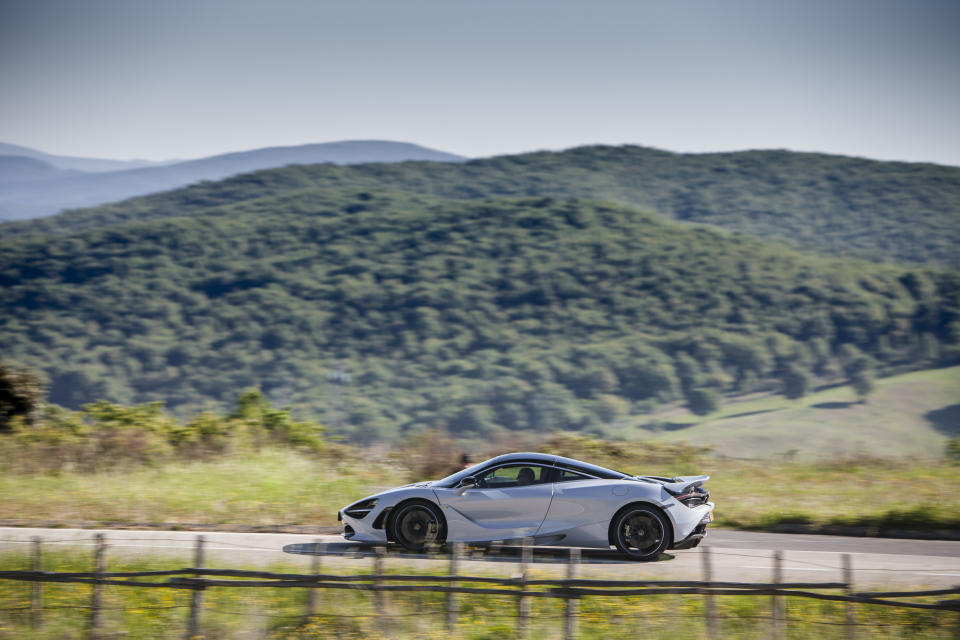
We can live with that, and if you can live with those lights, there's very little not to like about the first of McLaren's second wave of supercars. Last time the sticking point was the 12C looked too boring. This time, the only real gripe is that the 720S sounds a bit dull, and the sport exhaust doesn't put the 720S on par with a naturally aspirated note. But that's a problem for almost all of the new wave of turbocharged performance cars, from the 911 Turbo to Ferrari's 488 GTB. But not a problem for Lamborghini's naturally aspirated Huracan, which grows in appeal as every year passes, and another naturally aspirated performance engine passes on.
Even though the sport exhaust doesn't capture the aural excitement of the Lamborghini, the driving experience more than makes up for the relative quiet. Ignore the sound. What McLaren has built is what we always knew the 12C and 650S could and should be.
"They got hit over the head. We all know it, that the car didn't demonstrate enough energy, creative energy – passion, you could call it. It never looked wrong, it just looked ho-hum. It's like an athlete with an incredible figure wearing a sack."
That's what McLaren Automotive's Design Director Frank Stephenson had to say about the company's original supercar, the MP4-12C, a car that had its design finalized before he even started.
In approaching its comeback supercar with a race team's focus, McLaren made a crucial miscalculation. The 12C lacked the one thing that you can't put a number on: wow factor. And that was something the Band-Aid 650S rebranding could never fully fix. The 720S doesn't have that problem. Not close. This car is all wow.

The 720S is as polarizing as the 12C was bland, as innovative as its ancestor was predictable. Take the eye-socket headlamps, which cleverly, but controversially, take a tip from the tuner world, turning the headlamp hole into air intakes, and use slim LED lamps bridging the chasm for illumination. You might not like the way they look, but you'll admire them a whole lot more once you appreciate the science behind the styling.
Same with the rear quarter panels. The gaping air intakes convention says all mid-engined cars need between the rear wheel and the door are gone. They're hidden behind a fake door skin, the McLaren 570S's door 'tendon' bar taken to the next level.
If the visual effect is striking from the outside, revealing the long wheelbase in all its glory, like a drag motorcycle with its extended swing arm, it's no less jarring from beneath the bubble canopy. From the driver's seat I can see the division between the inner and outer body panels as I power down the start finish straight at Rome's Vallelunga race circuit. I've driven here a couple of times before, most recently in an Audi RS3, and before that for the launch of the original Lamborghini Aventador. So, basically never in anything that actually wanted to turn. Consider that remedied.

The 720S loves to turn. The steering is weightier this time because of geometry changes that increase the castor, but that only adds confidence as you nudge the wheel away from center, feeling the tires filtering the vital messages back to your hands.
And that's real feel, not the virtual panacea we so often get fobbed off with these days. McLaren tried electric-assist steering racks during development but couldn't get any to deliver the feel they wanted. The 720 keeps its hydraulic steering. It's not your turn yet, electric-assist.
Who'd have believed, even 15 years ago, that a supercar this powerful could be so forgiving? Driving the 720 hard feels entirely natural from the first corner as you push to the front tire's limits, feel the wheel lighten as you brush the brakes, then ease back on the gas to gently load up the rear tires. The balance is delicious, the way you can tease it by massaging the gas pedal, absolutely intuitive. It has that purity in its agility that you only get from being ruthless about mass.

Only a few weeks before this I drove the Bugatti Chiron, a car whose acceleration is so freakish it feels like it could sieve your internal organs through the pores of the skin on your back. A car that wants to convince you that trick's enough to forgive a gargantuan curb weight. Driving the 720S reminds you that it's never forgivable to let a sports car knock on the door of 4500lb, no matter how much performance it offers in payback.
The 720S weighs 3128lb full of fuel and a driver, and no doubt could have come in even lighter if McLaren had used the conventional sway bars it gave the 570S rather than the hydraulic roll control system the more senior cars get. But then it wouldn't be able to react to the dip at turn one, or the banking at turn two, nearly as quickly. McLaren calls this Proactive Chassis Control II. The hardware is essentially the same, but 12 extra sensors allow it to anticipate, rather then simply respond to situations.

PCCII might not sound sexy but owners will get more benefit from that than the new 'Drift Control' function, an ESP-based stability system that lets you tailor the amount of slide by sliding a finger left or right across a graphic on the nav screen. Not since the Mustang II King Cobra's graphics package has performance been so oversold: this is more 'slight oversteer' than 'drift' and we'd need more time to be sure about its consistency, though the idea of helping novice drivers approach the 720S huge limits in safety is sound.
Gadget fans will also appreciate the telemetry option that shows sector and lap times for the circuit, plus a trace that rises and falls to show braking and acceleration. Later, in the pits, I compare mine with chief test driver Chris Goodwin's: his looking like a graph of gas prices through the 1970s, mine like toilet paper sales over the same period.
But caught up in the moment, in the act of actually driving, you feel every bit as heroic as Goodwin. Taking the jink right after the pits with your foot buried deep into the carpet, pulling the car left again then standing on the middle pedal with all your might, marveling at stability the 650S never had, and catching a glimpse in the rear view mirror of the now-full-width rear deck spoiler hurling itself into the slipstream in airbrake mode: hot lapping the 720S an absolute scream. The only thing it can't do is scream back.

Behind your head, buried so low in the aluminum rear subframe that there's sadly nothing to see whatsoever, is an evolution of the engine that has underpinned every modern McLaren from the entry-level 540C to the halo-model P1 in some form or another.
A longer stroke takes it from 3.8-liters to 4.0. Power is up from the 641hp of the 650S to 710hp, or 720PS. Even the P1 only made 727hp before you factor in its hybrid add-on, and that car cost four times as much. This is proper next-level performance, taking the ordinary mid-range supercar to hypercar levels of go.
On paper, it's a monster, dispatching 62mph in 2.8sec and 124mph (200kmh) in 7.8sec. A Ferrari 488 GTB needs 3.0 and 8.3sec respectively. On pavement, it's no less impressive, spinning to 8000rpm, and feeling noticeably less laggy in this incarnation thanks to some new low-inertia twin-scroll turbos.

With the stock exhaust, you'd never know it. There's no flamboyant fanfare when you push the start button. Push the gas pedal and there are no sonic fireworks. If you want crazy noise, opt for the sport exhaust, which McLaren says is 30 percent louder and has a feature called 'loud start.' While the lack of sound from the regular exhaust might no impress everyone who gets in the car for 10 minutes, it's likely to win you over long term.
The 720S asks an existential question of the supercar: aren't these cars actually bought solely to administer shots of adrenaline in 10-minute long doses?
It certainly seems McLaren believes otherwise, like it wants you to think hard before walking past this and taking the Range Rover, or the E63, even if you are just commuting to work. The carbon chassis, which, along with the dihedral doors is unique in this sector, is now a 'monocage' including an integrated central roof bar, rather than a simple tub.

More than the extra stiffness this provides, what you notice is the way it's allowed McLaren's engineers to cut the rocker panel deep towards the floor at the base of the A-pillar. Instead of falling butt-first into the seat like you've tripped backwards down a well, you can actually climb aboard with some dignity. And now that the doors require 155mm less space to swing open, you can actually get out of the thing in a tight parking garage space too.
That's the surprise about the 720S: it looks like a nightmare to live with but is anything but. The visibility is excellent, both forward, past the A-pillars with their exposed carbon weave, a nice show-off touch–and more surprisingly, at the back.
Less so if you make use of the huge cargo area under the rear part of the canopy. McLaren dropped the engine's induction plenums by 4.7in, creating a new 7.4cu ft luggage space behind the rear seats that would be even more useful if the glass above it was hinged like it is in the 570GT. Factor in the generous 5.3cu ft space in the nose that swallowed two rolling bags full of camera gear on our way to the airport and you're looking at a supercar that thinks it's a GT.

And rides like one. Italy's roads are as rough as Germany's are smooth. The pavement is frequently broken and uneven and strewn with irritating little Fiats that we swat away with a squirt of right foot. The McLaren doesn't care. No, it's not an S-Class, but for a supercar like this, the McLaren is exceptionally comfortable.
As with other McLarens you still have to press the Active button on the dash before you can mess with the twin toggle switches governing the chassis and drivetrain setup. The difference this time is the car defaults to the medium 'Sport' setting in each. Switch to 'Track' and as well as the changes to roll stiffness and throttle mapping, the instrument binnacle swivels downwards to reveal a simpler, more focused digital readout.
Whatever the setting, you notice the extra steering weight more in road driving than you do on the track. That and the reduction in turbo lag. Both help dial you into the bitumen better than the 650S did. And if the steering needs a bit more arm muscle, it's at least better matched to the carbon brakes, which need a manly push: great for meting out the exact amount of woah you want, but you can easily find the car creeping in traffic because what feels like a high pedal effort isn't enough to hold the car stationary.

We can live with that, and if you can live with those lights, there's very little not to like about the first of McLaren's second wave of supercars. Last time the sticking point was the 12C looked too boring. This time, the only real gripe is that the 720S sounds a bit dull, and the sport exhaust doesn't put the 720S on par with a naturally aspirated note. But that's a problem for almost all of the new wave of turbocharged performance cars, from the 911 Turbo to Ferrari's 488 GTB. But not a problem for Lamborghini's naturally aspirated Huracan, which grows in appeal as every year passes, and another naturally aspirated performance engine passes on.
Even though the sport exhaust doesn't capture the aural excitement of the Lamborghini, the driving experience more than makes up for the relative quiet. Ignore the sound. What McLaren has built is what we always knew the 12C and 650S could and should be.
You Might Also Like

 Yahoo Autos
Yahoo Autos 